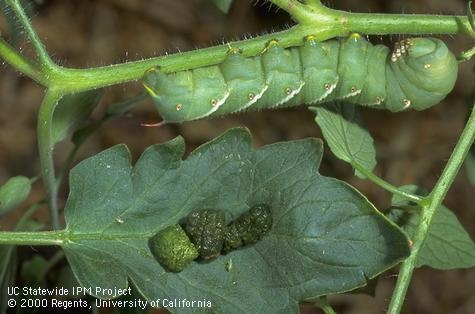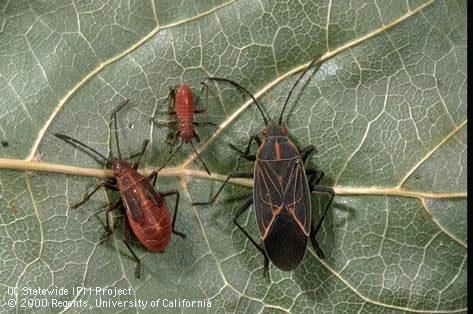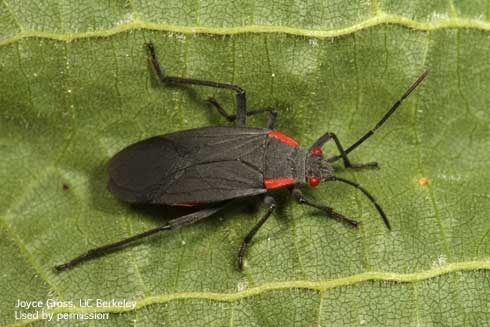Bug Problem: Green Worm or Red Boxed Beetle?
Advice for the Home Gardener from the Help Desk of the
UC Master Gardener Program of Contra Costa County
Client's Requests: I have these pests on EVERYTHING from my tomato plants to my Rose bushes & flowers to my Lambs Ear plant! I'm certain the green worms are eating these because I've seen them on the leaf undersides. However, I'm not certain if the beetles are eating as well. I have an infestation of both pests every year along with White Flies & Aphids!! ?? We've sprayed with ALL the common treatments from Neem Oil to calling the pest control man. They continue to come back and destroy nearly every flower, or plant I have. Any thoughts??? Thank you, Very frustrated!
Help Desk Response: Thank you for contacting the UC Master Gardener Program Help Desk. You asked about insects in your yard. There aren't insects named green horned worm or red boxed beetles, but you probably mean the tomato hornworm (a green worm with a pointy "horn" on its rear) and possibly the box elder bug or the red-shouldered bug.
T

The insect you refer to as red boxed beetles could be either box elder bugs or red-shouldered bugs, also known as golden rain tree or soapberry bugs. Neither of these bugs does much damage to ornamental or fruit trees. You might be seeing the red-shouldered bugs right now. They are out in numbers in my yard. They eat the seeds of the golden rain tree or other related plants, but nothing else. Both of these bugs are more of a nuisance than a pest that needs to be controlled. Here is more information about box elder bugs: http://ipm.ucanr.edu/PMG/PESTNOTES/pn74114.html.


You also mentioned problems with aphids and whiteflies which are very common pests throughout the County. The links below are to more information about both of these pests: http://ipm.ucanr.edu/PMG/PESTNOTES/pn7404.html and http://ipm.ucanr.edu/PMG/PESTNOTES/pn7401.html.
It is important to identify the pest before spraying. There are some pests that are controlled by natural predators that won't become more prevalent if the predators are indiscriminately killed by sprays. It is easier to deal with problems when they are caught early. As you notice something amiss, either damage from insects or disease, feel free to contact us. Photos of the problem/pest will help us diagnose it and enable us to send you information on what to do.
Please don't hesitate to contact us again if you have more questions.
| Don't miss our 2019 Great Tomato Plant Sale - Walnut Creek 3/30, Richmond 4/6, Antioch 4/13. Click here for more information:http://ccmg.ucanr.edu/tomato/ |
Help Desk of the UC Master Gardener Program of Contra Costa County (SEH)
Note: UC Master Gardeners Program of Contra Costa's Help Desk is available almost year-round to answer your gardening questions. Except for a few holidays (e.g., last 2 weeks December), we're open every week, Monday through Thursday for walk-ins from 9:00 am to Noon at 2380 Bisso Lane, Concord, CA 94520. We can also be reached via telephone: (925) 608-6683, email: ccmg@ucanr.edu, or on the web at http://ccmg.ucanr.edu/Ask_Us/. MGCC Blogs can be found at http://ccmg.ucanr.edu/HortCoCo/ You can also subscribe to the Blog.
Comments:
From the BLOG Editor... Yes, they are "Green Horned Tomato Worms" as described in the blog and in the backyard gardener discussions...
from my personal experience below... they can get quite big as described in the blog here in Contra Costa County... maybe up to 4" and they grow fast if food is available... along with the worm, you will also eventually have some very large moths some nights... because of their size you often see large fecal matter (1/4" black pellets on the ground), and if you get down on your knees in your tomato patch, you can actually hear and find them above the fecal matter munching on your tomato plants.. the worms can be hand-picked, but I usually wear gloves, they can be squirmy trying to pick them off the plants.. I still remember the vision of my neighbor collecting his share, putting on his rarely used motorcycle helmet (w/full-faced mask) and taking a brick to them on the sidewalk w/o any splatter on his face... with both of us wondering how they got there since we lived in a "new" subdivision surrounded by large open pastures... probably basically eggs in nursery bought plants and moths flying in...now the neighbors are the source and they are almost an annual problem at some level. If you have them and want abundant tomatoes you will have to remove them as I've often had plants almost completely "deleafed" in a day or two, usually leading to no or few tomatoes from the blossoms... they do munch on tomatoes as well...Editor.
Thanks Colin
Editor
Posted by Susi B on March 25, 2019 at 7:09 AM